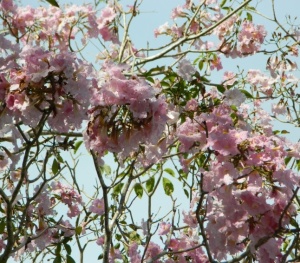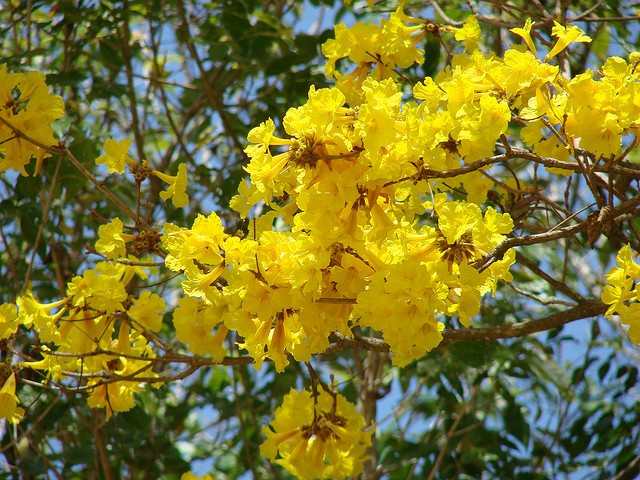Spring Came Early to Jaltemba Bay
Tara A. Spears



Spring is my favorite season. It is a time of rebirth, renewal, and rejuvenation. But this year I almost missed it since we experienced a very mild winter along the coast. Just as in cold latitudes the change of seasons is indicated by the appearance of spring flowers like hyacinths or tulips, in our sub-tropic zone we have trees burst into gorgeous flowers. As the thousands of orchid-like blooms fade and drop to the ground, then the leaves emerge on the previously barren branches. The area bloomers are almost totally finished and leafed out- more than a month early! The appearance of the lovely flowers typically go in rotation from yellow flowers first, then the pink flowering species, followed by the deep pink and orange colors. Seeing the bright flowers punctuate the green jungle foliage is like putting on your best lipstick to go dancing! Spring flowers just lift your spirits. One can see these exotic flowers throughout Jaltemba Bay communities as you stroll around town. The Shaving brush tree, Primavera tree, and the Royal Poinciana tree are stunning when in full bloom.![]()
The Shaving Brush tree is native to southern Mexico, El Salvador, Guatemala and Honduras. It is one of the first trees to bloom in Jaltemba Bay early February and March. This deciduous tree with succulent stems is a member of the Hibiscus family and is called Clavellina in Spanish. It’s easy to see how the blooms of the Shaving Brush tree got their name. I particularly like the casing of the flower that curl like gift-wrap ribbon.
The four-inch long bright magenta or light pink stamens are so profuse that the flower really does look like a delicate, psychedelic shaving brush. The spiky flowers grow from the tip of bare branches before leaves appear. But the show is a quick one, and soon the base of the tree is littered with what looks to be like pink troll-doll hair.
The beautiful primavera (Spanish for spring) tree grows wild north of La Penita along the highway to Las Varas. The Las Palmas plant nursery (vivero) has a couple of outstanding yellow-flowering trees by the nursery entrance. The specie with yellow flowers is called “Yubin de oro” or gold can. Framing the Guayabitos tennis courts are a row of mature, pink blooming primavera trees. The clusters of flowers are in stark contrast with the bare branches that will leaf out after the blooming finishes.
It has relatively smooth whitish bark and showy pink or yellow flowers in large panicles-clusters. Primavera is often considered the bat-flower family because many of the plants have large showy flowers that are pollinated by bats.
The beautiful flowers grow in clusters of 1 to 3 inches (3 to 8 cm) wide, becoming larger and more profuse as the tree matures. These are large trees that require full sun and plenty of space from tall buildings or other trees that might shade them, therefore primavera is an excellent specimen tree for landscaping tropical yards or boulevards as in Guayabitos. They attract bees as well as several species of hummingbirds.
The Royal Poinciana is a late spring bloomer when the other species have shed their flowers. A mature tree gets absolutely covered with bright orange flowers. The Royal Poinciana (sometimes called the tulip tree) can get 30 feet tall, so you can see them dotting the roadside or neighborhood from far away. The Royal Poinciana tree, which is commonly known as the flame tree or flamboyant, is a member of the bean family (Leguminosae) and is widely regarded as one of the most beautiful tropical trees in the world. As the trees mature, they develop broad umbrella-shaped crowns, and are often planted for their shade-giving properties. The delicate, fern-like leaves are composed of small individual leaflets, which fold up at the onset of dusk. The Poinciana tree produces brown, woody seed pods that reach lengths of up to two foot (60 cm) long that turn reddish-brown to almost black when ripe.![]()
Take time to enjoy the vibrant spring show that the area trees put on. Their riot of colors won’t last long!